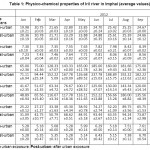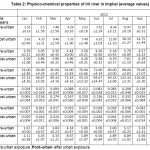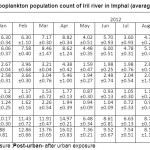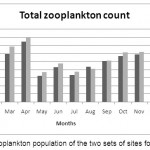Seasonal Variation of Zooplankton Population with Reference to Water Quality of Iril River in Imphal
Thankhum Saron1 and Bijen Meitei2 *
1
CMJ University,
Laitumkhrah,
Shillong,
793 003
Meghalaya
2
Directorate of Environment,
Porompat,
Imphal East,
795 005
Manipur
DOI: http://dx.doi.org/10.12944/CWE.8.1.16
Copy the following to cite this article:
Saron T, Meitei L. Seasonal Variation of Zooplankton Population with Reference to Water Quality of Iril River in Imphal. Curr World Environ 2013;8(1) DOI:http://dx.doi.org/10.12944/CWE.8.1.16
Copy the following to cite this URL:
Saron T, Meitei L. Seasonal Variation of Zooplankton Population with Reference to Water Quality of Iril River in Imphal. Curr World Environ 2013;8(1). Available from: http://www.cwejournal.org/?p=3352
Download article (pdf)
Citation Manager
Publish History
Select type of program for download
| Endnote EndNote format (Mac & Win) | |
| Reference Manager Ris format (Win only) | |
| Procite Ris format (Win only) | |
| Medlars Format | |
| RefWorks Format RefWorks format (Mac & Win) | |
| BibTex Format BibTex format (Mac & Win) |
Article Publishing History
| Received: | 2013-03-20 |
|---|---|
| Accepted: | 2013-04-12 |
The potential of rivers as good habitats for ichthyo-fauna seems degraded with onslaught of anthropogenic interference impairing the quality and quantity of river water. The Manipur Central Valley districts are endowed with many wetlands which are often connected with rivers and as such the rivers pose important source of fish resources. The recent changes in water quality impair the potential of the rivers to a significant degree. The Iril river, which is very important for water supply of the Imphal city also cater for the protein food need of the people around with its fish resources. Moreover ecologically the ichthyo-faunal biodiversity of the river is significant. While most of the other rivers in the Imphal city have lost such inevitable characteristics, the Iril river still maintain a part of its pristine features. However the onslaught of urban exposures impacts the river and the biotic components. The study on zooplankton population with reference to water quality was carried out. The results may reveal an in-depth inference for better conservation of the river while it is not too late. The river is connected with five very important major wetlands in the valley indirectly and knowledge of its ecological health is a good approach towards holistic means for overall aquatic ecosystem health in the beautiful valley of Manipur.
Discharge of waste and surface run off causes deleterious effect in flora and fauna and other aquatic organisms ( Sah et al., 2000). Water qualities of rivers have been deteriorated due to disposal of garbage, religious offerings, sewage, recreational and constructional activities in the catchment areas (Singh et al.,2012 ). The problem of anthropogenic environmental distortion continuously affects rivers ( Nandita Chakraborty et al., 1995).
There is indication that the headwaters to mouth, the physical features vary significantly within a lotic water system and present a continuous gradient of physical variations, which evolves association within biota and other a-biotic features ( Pathani and Upadhyay, 2006). Thus the biota of an aquatic ecosystem directly reflects the conditions existing in the environment ( Bhatt et al., 1984).
Monitoring of zooplankton communities is needed to allow us to predictively model the ecosystem (Deborah and Robert, 2009). The zooplankton are known not only to form an integral part of the lotic community but also contribute significantly to the biological productivity of the fresh water ecosystem (Makarewicz & Likens,1979). Zooplankton populations can expand in rivers by growth of the suspended organisms ( Talling & Rzoska, 1967) or by the hatching of resting eggs in river sediments (Moghraby, 1977). However zooplanktons are being transported as river inundates the floodplains because the numerous small lakes loss zooplanktons to the flow ( James and William, 1988 ).
Site Description
Manipur lies in the extreme part of the North-East India, a sub- Himalayan hilly state, stretching from 23o50´N - 25o 41´N and 93o 02´ E – 94o48´E. The total geographical area is 22, 327 sq. km of which only about 10% is the enchanting central valley and the rest is surrounding ranges of hills of altitude 800 m to 3000 m above the mean sea level. Thus the central valley comprises 2238 sq. km of which wetlands occupies about 524.51 sq. km. Iril river is one of the major tributaries of Manipur river system in the central valley district of Manipur. It originates from Lakhamei village of Senapati district near the border with Nagaland with some tributaries originating from Ukhrul district and ultimately flows through the valley to meet Imphal river in the southern suburb of Imphal city. Five sites were selected starting from the point where the river enter the greater Imphal city area and ending at the conjoining point with Imphal river as the river exit the greater Imphal area to be a part of Manipur river system. The extent of length of the river in the study area is about 20 kilometers.
Methodology
The five sampling sites comprises two in the upstream to Imphal city, one at Imphal city area and two in the downstream. Analyses were carried out in monthly interval in the year 2012. Studies on seasonal zooplankton population is based on Standard methods of APHA (1989), Adoni (1985), Lackey (1938), Edmondson (1974) and Needham and Needham (1966),. Nylon- bolting net (mesh size; 60-80 µm) was used for collecting zooplankton. Analysis of physico-chemical parameters were done based on standard methods of APHA ( 1989) and Trivedy and Goel (1984). For the statistical calculation including ANOVA (Analysis of variance) methods of Parker (1973), Trivedi, Goel and Trisal (1987) and Kothari (2004) were used in computing the analysis.
Results
The results of the studies are logically classified into two sets namely pre-urban exposure sites and post-urban exposure sites. Means of the sites for the respective category is taken and the results are reproduced as Table 1, 2 and 3. This categorization presents a vivid account if urban exposure of the river gives impact to water quality and zooplankton population. The temperature of water for pre-urban sites ranges from 19.98 ± 0.21 0C in January to 25.42 ± 0.02 0C in July and for post urban sites it ranges from 20.36 ± 0.19 0C in January to 25.61±0.16 0C in July.
The mean of PH value increases in the post urban exposure sites in the months ranging from February to May and September to November. There is, however, no significant co-relation of PH with zooplankton population. The value of PH ranges from 7.30± 0.10 in January to 8.42 ± 0.07 in August. In the post-urban sites it ranges from 7.23 ± 0.04 in January to 8.56 ± 0.15 in September. There is slight increase in the value of PH with the increase in river volume due to seasonal flood.
The conductivity value ranges from 65.00 ± 2.36 µ Siemens/ cm² in January to 185.00 ± 2.36 µSiemens/cm² in June for pre-urban sites. It ranges from 71.11 ± 6.94 µ Siemens/ cm² in January to 237.78 ± 15.03 µ Siemens/ cm² in June for the post-urban sites. There is no significant co-relation of conductivity with zooplankton population.
The Total dissolved solids (TDS) value ranges from 41.67 ± 2.35 ppm in January to 143.34 ± 9.43 ppm in August for pre-urban sites and for post-urban sites it ranges from 48.89 ± 6.94 ppm in January to 180.00 ± 8.82 ppm in August. It shows negative co-relation with Zooplankton population, r = -0.531, p> 0.05 and significant at 5% level for pre-urban sites however there is no significant co-relation in the post urban sites.
It is important to note that there is no significant co-relation of the physico-chemical parameters with zooplankton population in the post-urban sites. Turbidity ranges from 25.22 ± 0.12 NTU in January to 89.75 ± 3.56 NTU in August for pre-urban sites and for post-urban sites it ranges from 31.09 ± 3.05 NTU in January to 94.24 ± 1.34 NTU in August and no significant co-relation with zooplankton population.
Dissolved oxygen (DO) recorded minimum of 5.08 ± 0.00 ppm in March to maximum of 7.61 ± 0.14 ppm in September for pre-urban sites and minimum of 5.14 ± 0.31 ppm in May and maximum of 7.38 ± 0.12 ppm in August for post-urban sites. Free CO2 ranges from 1.43 ± 0.16 ppm in December to 13.97 ± 0.16 ppm in August for pre-urban sites and for post-urban sites it ranges from 3.01 ± 0.83 ppm in December to 18.33 ± 1.27 ppm in August .
Bio-chemical oxygen demand (B.O.D) of pre-urban sites showed negative co-relation with zooplankton population, r = -0.537, p > 0.05 and significant at 5% level. The value ranges from 2.29 ± 0.22 ppm in December to 5.79 ± 0.00 ppm in August for pre-urban sites and from 2.84 ± 1.07 ppm in December to 7.61 ± 1.10 ppm in August for post-urban sites. Hardness values for pre-urban sites ranges from 32.00 ± 2.83 ppm in January to 98.00 ± 2.83 ppm in August. For post-urban sites the value ranges from 37.33 ± 4.16 ppm in January to 123.33 ± 2.31 ppm in August. There is no significant co-relation with zooplankton population. There is no significant co-relation of Nitrate, Inorganic phosphate and Potassium with zooplankton population. The value of nitrate in pre-urban sites ranges from 0.034 ± 0.002 ppm in January to 0.238 ± 0.023 ppm in September. For post-urban sites the value ranges from 0.065 ± 0.034 ppm in January to 0.426 ± 0.084 ppm in September.
Inorganic phosphate content for pre-urban sites ranges from 0.014 ± 0.001 ppm in February to 0.042 ± 0.001 ppm in September. Whereas for post-urban sites it ranges from 0.024 ± 0.011 ppm in February to 0.075 ± 0.014 ppm in September.
The value of Potasium for pre-urban sites ranges from 1.17 ± 0.23 ppm in October to 5.17 ± 0.23 ppm in August whereas for the post-urban sites it ranges from 2.11 ± 0.38 ppm in January to 8.67 ± 0.67 ppm in April.
The Rotifera population count for pre-urban sites ranges from 3.60 ± 0.93 U/L in July to 8.82 ± 0.34 U/L in April. For post-urban sites it ranges from 4.48 ± 0.35 U/L in May to 8.62 ± 1.24 U/L in April.
For population count of Cladocera for the pre-urban sites, the values range from 1.59 ± 0.47 U/L in May to 4.38 ± 0.42 U/L in April. For post-urban sites it ranges from 1.94 ± 0.27 U/L in May to 5.46 ± 1.00 U/L in April.
The Copepoda population count for pre-urban sites ranges from 0.84 ± 0.17 U/L in December to 1.77 ± 0.13 U/L in April. For post-urban sites it ranges from 0.72 ± 0.33 U/L in July to 2.42 ± 0.33 U/L in October.
As a whole, ,the total zooplankton population for pre-urban sites ranges from 6.48 ± 0.34 U/L in May to 14.97 ± 0.21 U/L in April.
Thus the primary peak of population growth is in April with a secondary peak in November. For post urban sites, the time of primary and secondary peaks are in similar pattern even as the value of count ranges from 7.36 ± 0.21 U/L in May to 16.02 ± 0.83 U/L in April.
The sudden drop of zooplankton population from April to May is due to early seasonal rain followed by flood. ANOVA (Analysis of variance) is calculated for the three zooplankton groups. For pre-urban sites the calculated value of F-ratio is 76.6 and for post-urban sites the F-ratio is 75.43, both of which are very much greater than the table value of 3.32 at 5% level with d.f. being v1=2 and v2 = 33.
Thus there is significant difference in sample means for the three groups of zooplanton. It is therefore concluded that the change in population of zooplankton population during the seasons is highly significant.
Discussions
From the results it can be established that zooplankton population of the river has no significant co-relation with most of the physico-chemical parameters except for Total dissolved solids (T.D.S.) and Bio-chemical oxygen demand ( B.O.D.) in the pre-urban sites. The negative co-relation may rather be established for decrease in population due to flooding of the river than any possible impact of the values of the parameters.
Though the F-ratio for variance of pre-urban to post urban sites of Nitrate ( 5.59 at 5% level with d.f. being v1= 1 and v2= 22 when the table value is 4.30) and Inorganic phosphate (7.241 at 5% level with d.f. being v1= 1 and v2= 22 when the table value is 4.30) are significant, these parameters do not affect zooplankton population in pre and post urban exposure since there is no significant variance of the later in the two sets of sites. The change in water quality of the river, with reference to the remaining physico-chemical parameters, shows no significant variance after urban exposure (except for Inorganic phosphate and Nitrate).
Though total zooplankton population is negatively co-related with TDS and BOD, the two physico-chemical parameters exhibit no variance in pre- and post-urban exposures, and there is no significant variation of the zooplankton population in the two sets of observations. The peculiar river basin setting of Iril river in the area, that is natural reservoir like feature, help in dilution of the pollutants specially in two of the post-urban sites. It is formed due to confluence of heavily silt loaded streams in the midst.
Moreover on account of the rivers situation at the periphery of the main urban area and no particular sewage draining into the river, pollution of the river is at a low level.
 |
Table 1: Physico-chemical properties of Iril river in Imphal (average values) Click here to View table |
 |
Table 2: Physico-chemical properties of Iril river in Imphal (average values) Click here to View table |
 |
Table 3: Zooplankton population count of Iril river in Imphal (average values in U/L) Click here to View table |
 |
Figure 1: Mean zooplankton population of the two sets of sites for Iril river 2012 Click here to View table |
Plankton densities in unregulated tropical rivers are often low ( James & William,1988). Rzoska (1978) found that reproduction of zooplankton in rivers is rarely observed at velocities in excess of 0.4 m. s-1. The drop of population in May be due to this reason of increased velocity. Velocity of the river water flow is maximal during flood time. Nandita Chakraborty et al., (1995) established role of nutrient gradient in unequal distribution of plankton species in Hoogly river.
However significant co-relation is not observed in the present studies, which may be due to very low level of nutrient content in the study sites. Pathani and Upadhyay (2006) reported increase of zooplankton population from winter season and reaching maximum in summer.
The present finding is in similar patter except for a slight decline in the month of December. It thereby creates two peaks –one primary peak of zooplankton population in April (Spring) and one secondary peak in November (Autumn). The primary peak could have been shifted to later month of summer season if the arrival of seasonal rain was normal. This season early seasonal rain accompanied with high flood in May could have led to decrease in zooplankton population in May. The bimodal pattern of this zooplankton population peak is grossly in association with findings, of Mathew (1978) and Sinha (1992). Bhatt et al., (1984) reported maximal zooplankton population during the period of minimum velocity.
The present peak in April is in association with this observation. Exposure to contaminants can severely impact zooplankton (Bradley and Roberts, 1987) but the insignificant variation of zooplankton population of pre and post urban exposure sites in the present studies is associated with low pollution level even after the river enter the urban area.
Conclusion
As for the present time, pollution level of Iril river is not alarming and conservation of the river is very much needed for preventing further ecological deterioration, because the water of the river is ultimately needed for water supply of the Imphal city. Moreover Iril is the only river in the Imphal area keeping intake its bio-diversity specially the ichthyo-fauna. Monitoring of zooplankton communities is needed to allow us to predictively model the ecosystem of Iril river and it will be helpful in modeling for conservation of the river ecosystem.
References
- Adoni, A.D., Workbook on Limnology. Indian MAB Committee Dept. of Envi, Govt. of India. Pratibha Publishers, Sagar, India. p. 216(1985).
- Alexander Singh, Th., Bijen Meitei, L.,and Sanamacha Meetei, N., Distribution Pattern of Enteropathogens in Greater Imphal Area of Imphal River, Manipur. Current world Environment Vol. 7( 2 ), 259-265 (2012).
- APHA ,Standard Methods for the Examination of Water and Waste- Water Analysis. (17th Edn.), Washington D.C. (1989).
- Bhatt, S.D., Yashodhara Bisht and Usha Negi, Ecology of the Limnofauna in the River Kosi of the Kumaun Himalaya (Uttar Pradesh). Proc. Indian natn. Sci. Acad. B50 No 4 pp 395-405 (1984).
- Bradley, B.P., Roberts, M.H.,Jr., Effects of contaminants on estuarine zooplankton. In S.K. Majumdar, L.W. Hall, Jr., and H.M. Austin, Contaminant Problems and Management of Living Chesapeake Bay Resources, The Pennsylvania Academy of Science, Philadelphia, Pa.,PP.417-441(1987).
- Deborah K. Steinberg and Robert H. Condon, Zooplankton of the York River Journal of Costal Research,Sl.57: 66-79(2009).
- Edmondson, W.T., A simplified method for counting phytoplankton. In: A manual on methods of or measuring primary production in aquatic Environment . R.A. Vollen weider (ed.), 1BP 12(1974).
- James F. Saunders, III & William M. Lewis,Jr., Zooplankton abundance and transport in a tropical white- water river. Hydrobiologia 162:147-155(1988), http://dx.doi.org/10.1007/BF00014537
- Kothari, C.R., Research methodology Methods and Techniques (Second revised edition), New Age International Publishers , 401 pp.(2004).
- Lackey, J.B., The manipulation and counting of river plankton and changes in some organisms due to formation preservation. U.S. Public Health Report, 53 : 2080-2093(1938), http://dx.doi.org/10.2307/4582717
- Makarewicz, J. C., and Likens, G. E., Structure and function of the zooplankton community of mirror lake, New Hampshire. Ecol. Monogr.19 109-127(1979), http://dx.doi.org/10.2307/1942575
- Mathew, P.M., Limnological investigation on the plankton of Govindgarh lake and its correlation with physico-chemical factors. p. 46-55, IN : Proc. Sem. Ecol. Fisheries Freshwater Reservoirs (Saigal, B.N. Ed.). CIFRI, Barrackpore, November, 27-29, 1969,(1978).
- Moghraby, A. el., A study of diapauses of zooplankton in a tropical river-the Blue Nile. Freshwat. Biol. 7: 207 -212(1977), http://dx.doi.org/10.1111/j.1365-2427.1977.tb01669.x
- Nandita Chakraborty, Chakrabarti, P.K., Vinci, G.k., and Sugunan, V.V., Spatiotemporal distribution pattern of certain plankton of river Hooghly. J.Inland Fish. Soc. India 27 ( 1 ). 1995: 6-121(1995).
- Needham, J.G. and Needham, P.R., A Guide to the study of Freshwater Biology. Holden-Day, Inc. San Fransisco. pp. 108(1966).
- Parker, R.E., Introductory Statistics for Biology.Edward Arnold (publisher) Ltd. 25-Hill Street, London(1973).
- Pathani, S.S. and Upadhyay, K.K., An inventory on zooplankton, zoobenthos and fish fauna in the river Ramganga (W) of Uttaranchal., India. ENVIS Bulletin Vol. 14(2): Himalaya Ecology(2006).
- Rzoska, J., On the Nature of Rivers. Dr W. Junk, The Hague. Pp. 67,(1978), http://dx.doi.org/10.1007/978-94-017-2480-7
- Sah, J.P., Sah, S.K., Acharya, P., Pant, D. and Lance, V.A., Assessment of water pollution in the Narayani river, Nepal.Intl. J. Ecol. & Environ. Sci.26: 235-252 (2000).
- Sinha, R.K. , Rotifer population of Ganga near Patna, Bihar (India). Proc. Nat. Acad. Sci., India 62 (B) III(1992).
- Talling, J. F. & Rzoska, J., The development of plankton in relation to hydrological regime in the Blue Nile. J. Ecol. 55: 637-662(1967), http://dx.doi.org/10.2307/2258415
- Trivedy, R.K. and Goel, P.K., Chemical and Biological Methods of water pollution studies. Environmental publication, Karad, 215 pp. (1984).
- Trivedy, R.K. ,Goel, P.K. and Trisal, C.L., Practical Methods in Ecology and Environmental Science. Environmental publication, Karad , 340 pp(1987).






